Asclepias
Asclepias is a genus of herbaceous, perennial, flowering plants known as milkweeds, named for their latex, a milky substance containing cardiac glycosides termed cardenolides, exuded where cells are damaged.[3][4][5] Most species are toxic to humans and many other species, primarily due to the presence of cardenolides, although, as with many such plants, there are species that feed upon them (i.e. leaves) and from them (i.e. nectar). The genus contains over 200 species distributed broadly across Africa, North America, and South America.[6] It previously belonged to the family Asclepiadaceae, which is now classified as the subfamily Asclepiadoideae of the dogbane family, Apocynaceae.
The genus was formally described by Carl Linnaeus in 1753,[7] who named it after Asclepius, the Greek god of healing.[8]
Milkweed flowers



Members of the genus Asclepias produce some of the most complex flowers in the plant kingdom, comparable to orchids in complexity. Five petals reflex backwards revealing a gynostegium (fused stamen filaments and styles) surrounded by a five-membrane corona. The corona is composed of a five paired hood and horn structure with the hood acting as a sheath for the inner horn. Glands holding pollinia are found between the hoods. The size, shape and color of the horns and hoods are often important identifying characteristics for species in the genus Asclepias.[9]
Pollination in this genus is accomplished in an unusual manner. Pollen is grouped into complex structures called pollinia (or "pollen sacs"), rather than being individual grains or tetrads, as is typical for most plants. The feet or mouthparts of flower-visiting insects such as bees, wasps and butterflies, slip into one of the five slits in each flower formed by adjacent anthers. The bases of the pollinia then mechanically attach to the insect, so that a pair of pollen sacs can be pulled free when the pollinator flies off, assuming the insect is large enough to produce the necessary pulling force (if not, the insect may become trapped and die).[10] Pollination is effected by the reverse procedure, in which one of the pollinia becomes trapped within the anther slit. Large-bodied hymenopterans are the most common and best pollinators, accounting for over 50% of all Asclepias pollination[11], whereas monarch butterflies are poor pollinators of milkweed.[4]


Asclepias species produce their seeds in pods termed follicles. The seeds, which are arranged in overlapping rows, bear a cluster of white, silky, filament-like hairs known as the coma[12] (often referred to by other names such as pappus, "floss", "plume", or "silk"). The follicles ripen and split open, and the seeds, each carried by its coma, are blown by the wind. Some, but not all, milkweeds also reproduced by clonal (or vegetative) reproduction.
Ecology
American milkweeds are an important nectar source for native bees, wasps, and other nectar-seeking insects, though non-native honey bees commonly get trapped in the stigmatic slits and die.[10][13] Milkweeds are also the larval food source for monarch butterflies and their relatives, as well as a variety of other herbivorous insects (including numerous beetles, moths, and true bugs) specialized to feed on the plants despite their chemical defenses.[4]
Milkweeds use three primary defenses to limit damage caused by caterpillars: hairs on the leaves, cardenolide toxins, and latex fluids. Data from a DNA study indicate that, generally, more recently-evolved milkweed species ("derived" in botany parlance) use these preventative strategies less but grow faster than older species, potentially regrowing faster than caterpillars can consume them.[14][15]
Research indicates that the very high cardenolide content of Asclepias linaria reduces the impact of the OE parasite, Ophryocystis elektroscirrha, on the monarch butterfly, Danaus plexippus. By contrast, some species of Asclepias are extremely poor sources of cardenolides, such as Asclepias fascicularis, Asclepias tuberosa, and Asclepias angustifolia.
Uses
Milkweed is not grown commercially in large scale, but the plant has had many uses throughout human history.[4] Milkweed has a long history of both medicinal, every day and, military use that most people aren’t even aware of. The Omaha people, from Nebraska, the Menomin which were from Wisconsin and upper Michigan, the Dakota’s from Minnesota and, the Ponca people from Nebraska used it for a medicinal and everyday usage ages ago. They used it for everything from a diarrheic, relief from sore throats, it was chewed for swelling and rashes, new mothers that could not produce milk would drink it, it was used to treat colic, it was used to expel tapeworms, it was used to cure snakebite and for a contraceptive. Heart-leaf milkweed was used by the Miwok people of California for its stems, which they dried and used for cords such as strings and ropes.[16] The milkweed filaments from the coma (the "floss") are hollow and coated with wax, and have good insulation qualities. During World War II, more than 5,000 t (5,500 short tons) of milkweed floss was collected in the United States as a substitute for kapok.[17][18] Milkweed is grown commercially as a hypoallergenic filling for pillows[19] and as insulation for winter coats.[20]
A study of the insulative properties of various materials found that milkweed floss was outperformed by other materials in terms of insulation, loft, and lumpiness, but it scored well when mixed with down feathers.[21] Milkweed fibers are also used to clean up oil spills.[22]

The bast fibers of some species can be used for rope. Milkweed latex contains about two percent latex and was attempted as a source of natural rubber by both Nazi Germany and the United States during World War II. No record has been found of large-scale success.
Asclepias is also known as "Silk of America"[23] which is a strand of common milkweed (Asclepias syriaca) gathered mainly in the valley of the Saint Lawrence River in Canada. The silk is used in thermal insulation, acoustic insulation, and oil absorbents.[24][25]
Milkweed also contains cardiac glycoside poisons that inhibit animal cells from maintaining a proper K+, Ca2+ concentration gradient.[5] As a result, many peoples of South America and Africa used arrows poisoned with these glycosides to fight and hunt more effectively. Milkweed is toxic and may cause death when animals consume large quantities of the plant. Milkweed also causes mild dermatitis in some who come in contact with it. Nonetheless, it can be made edible if properly processed.[4]
The leaves of Asclepias species are a food source for monarch butterfly larvae and some other milkweed butterflies.[4] These plants are often used in butterfly gardening and monarch waystations.[26]
However, some milkweed species are not suitable for butterfly gardens and monarch waystations. For example, Asclepias curassavica, or tropical milkweed, is often planted as an ornamental in butterfly gardens. Year-round plantings in the USA are controversial and criticised, as they may be the cause of new overwintering sites along the U.S. Gulf Coast, leading to year-round breeding of monarchs.[27] This is thought to adversely affect migration patterns, and to cause a dramatic buildup of the dangerous parasite, Ophryocystis elektroscirrha.[28] New research also has shown that monarch larvae reared on tropical milkweed show reduced migratory development (reproductive diapause), and when migratory adults are exposed to tropical milkweed, it stimulates reproductive tissue growth.[29]
Monarch caterpillars do not favor butterfly weed (Asclepias tuberosa) because the leaves of that milkweed species contain little toxin (cardiac glycosides).[citation needed] Some other milkweeds may have similar characteristics.
Species
Some Asclepias species:
 |
Asclepias albicans | Whitestem milkweed, native to the Mojave and Sonoran deserts |
 |
Asclepias amplexicaulis | Blunt-leaved milkweed, native to central and eastern United States |
 |
Asclepias asperula | Antelope horns, native to American southwest and northern Mexico |
 |
Asclepias californica | California milkweed, native to central and southern California |
 |
Asclepias cordifolia | Heart-leaf milkweed, native to the Sierra Nevada and Cascade Range up to 2000 m. |
 |
Asclepias cryptoceras | Pallid milkweed, native to the western United States. |
 |
Asclepias curassavica | Scarlet milkweed, tropical milkweed, bloodflower, bastard ipecacuanha, native to the American tropics, introduced to other continents |
 |
Asclepias curtissii | Curtiss's milkweed, endemic to sandy areas of Florida |
 |
Asclepias eriocarpa | Woollypod milkweed, native to California, Baja California, and Nevada |
 |
Asclepias erosa | Desert milkweed, native to California, Arizona, and Baja California |
 |
Asclepias exaltata | Poke milkweed, native to eastern North America |
 |
Asclepias fascicularis | Narrow-leaf milkweed, native to Western United States |
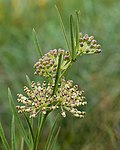 |
Asclepias hirtella | Tall green milkweed |
 |
Asclepias humistrata | Sandhill milkweed, native to southeastern United States |
 |
Asclepias incarnata | Swamp milkweed, native to wetlands of North America |
| Asclepias involucrata | ||
 |
Asclepias lanceolata | Lanceolate milkweed (Cedar Hill milkweed), native to coastal plain of eastern United States from Texas to New Jersey |
 |
Asclepias linaria | Pine needle milkweed, native to Mojave and Sonoran deserts |
| Asclepias linearis | Slim milkweed | |
 |
Asclepias meadii | Mead's milkweed, native to midwestern United States |
| Asclepias nivea | ||
 |
Asclepias nyctaginifolia | Mojave milkweed, native to the American southwest |
| Asclepias obovata | Pineland milkweed | |
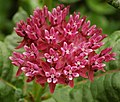 |
Asclepias purpurascens | Purple milkweed, native to eastern, southern, and midwestern United States |
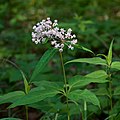 |
Asclepias quadrifolia | Four-leaved milkweed, native to eastern United States and Canada |
 |
Asclepias rubra | Red milkweed |
 |
Asclepias solanoana | Serpentine milkweed, native to northern California |
 |
Asclepias speciosa | Showy milkweed, native to western United States and Canada |
 |
Asclepias subulata | Rush milkweed, leafless milkweed, native to southwestern North America |
 |
Asclepias subverticillata | Horsetail milkweed[30] |
 |
Asclepias sullivantii | Sullivant's milkweed |
 |
Asclepias syriaca | Common milkweed |
 |
Asclepias texana | Texas milkweed |
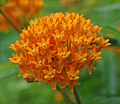 |
Asclepias tuberosa | Butterfly weed, pleurisy root |
 |
Asclepias uncialis | Wheel milkweed |
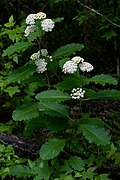 |
Asclepias variegata | White milkweed |
 |
Asclepias verticillata | Whorled milkweed |
| Asclepias vestita | Woolly milkweed | |
 |
Asclepias viridiflora | Green milkweed |
 |
Asclepias viridis | Green antelopehorn, spider milkweed |
 |
Asclepias welshii | Welsh's milkweed |
There are also 12 species of Asclepias in South America, among them: A. barjoniifolia, A. boliviensis, A. curassavica, A. mellodora, A. candida, A. flava, and A. pilgeriana.
Formerly classified species
Species formerly classified under the genus Asclepias include:
- Calotropis gigantea (L.) W.T.Aiton (as A. gigantea L.)
- Calotropis procera (Aiton) W.T.Aiton (as A. procera Aiton)
- Cynanchum louiseae Kartesz & Gandhi (as A. nigra L.)
- Cynanchum thesioides (Freyn) K.Schum. (as A. sibirica L.)
- Funastrum clausum (Jacq.) Schltr. (as A. clausa Jacq.)
- Gomphocarpus cancellatus (Burm.f.) Bruyns (as A. cancellatus Burm.f. or A. rotundifolia Mill.)
- Gomphocarpus fruticosus (L.) W.T.Aiton (as A. fruticosa L.)
- Marsdenia macrophylla (Humb. & Bonpl. ex Willd.) E.Fourn. (as A. macrophylla Humb. & Bonpl. ex Schult.)
- Marsdenia tenacissima (Roxb.) Moon (as A. tenacissima Roxb.)
- Matelea maritima (Jacq.) Woodson (as A. maritima Jacq.)
- Sarcostemma acidum (Roxb.) Voigt (as A. acida Roxb.)
- Sarcostemma viminale (L.) R.Br. (as A. viminalis (L.) Steud.)
- Telosma cordata (Burm.f.) Merr. (as A. cordata Burm.f.)
- Telosma pallida (Roxb.) Craib (as A. pallida Roxb.)
- Tylophora indica (Burm.f.) Merr. (as A. asthmatica L.f.)
- Vincetoxicum hirundinaria Medik. (as A. vincetoxicum L.)
- Vincetoxicum pycnostelma Kitag. (as A. paniculata Bunge)
- Xysmalobium undulatum (L.) R.Br. (as A. undulata L.)[31]
References
- ^ a b "Taxon: Asclepias L." Germplasm Resources Information Network. United States Department of Agriculture. 2003-03-13. Retrieved 2013-02-05.
- ^ "Asclepias". NCBI taxonomy. Bethesda, MD: National Center for Biotechnology Information. Retrieved 10 August 2018.
- ^ Singh, B.; Rastogi, R.P. (1970). "Cardenolides-glycosides and genins". Phytochemistry. 9 (2): 315–331. doi:10.1016/s0031-9422(00)85141-9.
- ^ a b c d e f Agrawal, Anurag (2017-03-07). Monarchs and Milkweed: A Migrating Butterfly, a Poisonous Plant, and Their Remarkable Story of Coevolution. Princeton University Press. ISBN 9781400884766.
- ^ a b Agrawal, Anurag A.; Petschenka, Georg; Bingham, Robin A.; Weber, Marjorie G.; Rasmann, Sergio (2012-04-01). "Toxic cardenolides: chemical ecology and coevolution of specialized plant–herbivore interactions". New Phytologist. 194 (1): 28–45. doi:10.1111/j.1469-8137.2011.04049.x. ISSN 1469-8137. PMID 22292897.
- ^ "Asclepias L." Plants of the World Online. Royal Botanical Gardens Kew. Retrieved 2018-11-23.
- ^ "Asclepias". ipni.org. International Plant Names Index. Retrieved 2018-11-23.
- ^ Quattrocchi, Umberto (29 November 1999). CRC World Dictionary of Plant Names: Common Names, Scientific Names, Eponyms, Synonyms, and Etymology. CRC Press. p. 211. ISBN 978-0-8493-2673-8.
Latin asclepias and Greek asklepias for the common swallowwort; Asclepius, Greek god of medicine, the worship of Asclepius was centered in Epidaurus. See W.K.C. Guthrie, The Greeks and Their Gods, 1950; Carl Linnaeus, Species Plantarum. 214. 1753 and Genera Plantarum. Ed. 5. 102. 1754.
- ^ http://orbisec.com/milkweed-flower-morphology-and-terminology/ Milkweed Flower Morphology
- ^ a b Robertson, C. (1887) Insect relations of certain asclepiads. I. Botanical Gazette 12: 207–216
- ^ Ollerton, J. & S. Liede. 1997. Pollination systems in the Asclepiadaceae: a survey and preliminary analysis. Biological Journal of the Linnean Society (1997), 62: 593–610.
- ^ Sacchi, C.F. (1987) Variability in dispersal ability of Common Milkweed, Asclepias syriaca, seeds, Oikos Vol. 49, pp. 191–198
- ^ Frost, S.W. (1965). "Insects and pollinia". Ecology. 46 (4): 556–558. doi:10.2307/1934896. JSTOR 1934896.
- ^ Ramanujan, Krishna (Winter 2008). "Discoveries: Milkweed evolves to shrug off predation". Northern Woodlands. 15 (4): 56.
- ^ Agrawal, Anurag A.; Fishbein, Mark (2008-07-22). "Phylogenetic escalation and decline of plant defense strategies". Proceedings of the National Academy of Sciences. 105 (29): 10057–10060. doi:10.1073/pnas.0802368105. ISSN 0027-8424. PMC 2481309. PMID 18645183.
- ^ Johnson, Glen A (2019). Milkweed of the United States including Puerto Rico and the US Virgin Islands. Amazon KDP. p. 7. ISBN 9781081170653.
- ^ Hauswirth, Katherine (2008-10-26). "The Heroic Milkweed". The Christian Science Monitor. Retrieved 2014-02-14.
- ^ Wykes, Gerald (2014-02-04). "A Weed Goes to War, and Michigan Provides the Ammunition". MLive Media Group. Michigan History Magazine. Retrieved 2014-02-14.
- ^ Evangelista, R.L. (2007). "Milkweed seed wing removal to improve oil extraction". Industrial Crops and Products. 25 (2): 210–217. doi:10.1016/j.indcrop.2006.10.002.
- ^ Bernstein, Jaela (2016-10-13). "How a Quebec company used a weed to create a one-of-a-kind winter coat". CBC News. Retrieved 2018-01-05.
- ^ McCullough, Elizabeth A. (April 1991). "Evaluation of Milkweed Floss as an Insulative Fill Material". Textile Research Journal. 61 (4): 203–210. doi:10.1177/004051759106100403.
- ^ "Milkweed touted as oil-spill super-sucker — with butterfly benefits". cbc.ca. 2 December 2014.
- ^ Charles Sigisbert, Sonnini (1810). Traité de l'asclépiade.
- ^ Choi, Hyung Min; Cloud, Rinn M. (1992). "Natural sorbents in oil spill cleanup". Environmental Science & Technology. 26 (4): 772. doi:10.1021/es00028a016.
- ^ "La soie d'Amérique passe en production industrielle". Radio Canada. Retrieved 20 December 2015.
- ^ (1) "Butterfly Gardening: Introduction". University of Kansas: Monarch Watch. Archived from the original on 2 February 2020. Retrieved 9 March 2020.
(2) "Monarch Watch: Monarch Waystation Program". University of Kansas, Entomology Department. Archived from the original on 18 Nov 2019. Retrieved 26 February 2019.
(3) "Monarch Garden Plants" (PDF). San Francisco, California: Pollinator Partnership. Archived from the original (PDF) on 9 March 2020. Retrieved 9 March 2020. - ^ Howard, Elizabeth; Aschen, Harlen; Davis, Andrew K. (2010). "Citizen Science Observations of Monarch Butterfly Overwintering in the Southern United States". Psyche: A Journal of Entomology. 2010: 1. doi:10.1155/2010/689301.
- ^ Satterfield, D. A.; Maerz, J. C.; Altizer, S (2015). "Loss of migratory behaviour increases infection risk for a butterfly host". Proceedings of the Royal Society B: Biological Sciences. 282 (1801): 20141734. doi:10.1098/rspb.2014.1734. PMC 4308991. PMID 25589600.
- ^ Majewska, Ania A.; Altizer, Sonia (16 August 2019). "Exposure to Non-Native Tropical Milkweed Promotes Reproductive Development in Migratory Monarch Butterflies". Insects. 10 (8): 253. doi:10.3390/insects10080253. PMC 6724006. PMID 31426310.
{{cite journal}}: CS1 maint: unflagged free DOI (link) - ^ Asclepias subverticillata (A. Gray) Vail, USDA PLANTS
- ^ "GRIN Species Records of Asclepias". Germplasm Resources Information Network. United States Department of Agriculture. Retrieved 2011-02-22.
- Everitt, J.H.; Lonard, R.L.; Little, C.R. (2007). Weeds in South Texas and Northern Mexico. Lubbock: Texas Tech University Press. ISBN 0-89672-614-2

